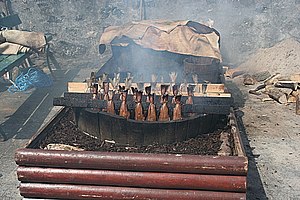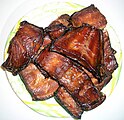Smoked fish

Smoked fish is fish that has been cured by smoking. Foods have been smoked by humans throughout history. Originally this was done as a preservative. In more recent times fish is readily preserved by refrigeration and freezing and the smoking of fish is generally done for the unique taste and flavour imparted by the smoking process.
Smoking process
[edit]

According to Jeffrey J. Rozum, "The process of smoking fish occurs through the use of fire. Wood contains three major components that are broken down in the burning process to form smoke. The burning process is called pyrolysis, which is simply defined as the chemical decomposition by heat. The major wood components are cellulose, hemicellulose and lignin."[2]
"The major steps in the preparation of smoked fish are salting (bath or injection of liquid brine or dry salt mixture), cold smoking, cooling, packaging (air/vacuum or modified), and storage. Smoking, one of the oldest preservation methods, combines the effects of salting, drying, heating and smoking. Typical smoking of fish is either cold (28–32 °C) or hot (70–80 °C). Cold smoking does not cook the flesh, coagulate the proteins, inactivate food spoilage enzymes, or eliminate the food pathogens, and hence refrigerated storage is necessary until consumption",[3] although dry-cured hams are cold-smoked and require no refrigeration.[citation needed]
Smokehouses
[edit]A smokehouse is a building where fish or meat is cured with smoke. In a traditional fishing village, a smokehouse was often attached to a fisherman's cottage. The smoked products might be stored in the building, sometimes for a year or more.[4] Traditional smokehouses served both as smokers and to store the smoked fish. Fish could be preserved if it was cured with salt and cold smoked for two weeks or longer.[4] Smokehouses were often secured to prevent animals and thieves from accessing the food.[4]
Traditional versus mechanical
[edit]Today there are two main methods of smoking fish: the traditional method and the mechanical method. The traditional method involves the fish being suspended in smokehouses over slowly smouldering wood shavings. The fish are left overnight to be naturally infused with smoke.[5]
In the mechanical method smoke is generated through the use of smoke condensates, which are created by the industrial process of turning smoke into a solid or liquid form. The flow of smoke in the mechanical kiln is computer controlled and the fish generally spend less time being smoked than in a traditional kiln.[2]
Laminar air-flow technology allows mechanical kilns to achieve a higher production rate, while the use of micro-processors has allowed mechanical kiln smokers increased sensor coverage within the kiln.[2][6]
High-quality smoked fish is a high-end product sought after by restaurants.[5][7]
-
Smoked fish in smoker
-
Smoking fish at the highland games
-
Mackerel cold-smoked for eight hours and then hot-smoked for an hour in a homemade smoker
-
Fish being smoked in Tanji, The Gambia
Types
[edit]This section needs additional citations for verification. (January 2021) |
The most common types of smoked fish in the US are salmon, mackerel, whitefish and trout, although other smoked fish is also available regionally or from many ethnic stores. Salmon, mackerel and herring are universally available both hot-smoked and cold-smoked, while most other fish is traditionally preserved by only one of the smoking methods.
A common name for cold-smoked salmon is lox, of which many different types are available, usually identified by point of origin (e.g., from Scotland, Norway, Holland, the Pacific, and Nova Scotia, Canada—the latter usually identified as "Nova lox" or just "Nova"). Traditionally, "lox" designates brined rather than smoked salmon,[8] but the linguistic boundary between the two types of products has become blurred.[9] "Gravad lax" or gravlax remains the only type that is unmistakably not smoked fish. However, commercial labels still identify most smoked products as "smoked salmon" rather than "lox".
Most other smoked fish in the US is hot-smoked, although cold-smoked mackerel is always available in East-European delis, along with cold-smoked sturgeon, sea bass, halibut or turbot and many other varieties. Jewish delis often sell, in addition to lox, hot-smoked whitefish, mackerel, trout, and sablefish (also sometimes referred to as black cod in its fresh state). Along the Mississippi River, hot-smoked locally caught sturgeon is also available. Traditionally, in the US, cold-smoked fish, other than salmon, is considered "raw" and thus unsafe to consume without cooking. For this reason, in the US, cold-smoked fish is largely confined to specialty and ethnic shops.
In the Netherlands, commonly available varieties include both hot- and cold-smoked mackerel, herring and Baltic sprats. Hot-smoked eel is a specialty in the Northern provinces, but is a popular deli item throughout the country.
Smoked fish is a prominent item in Russian cuisine, Ashkenazi Jewish cuisine, and Scandinavian cuisine, as well as several Eastern and Central European cuisines and the Pacific Northwest cuisine.
In Israeli cuisine, smoked trout is traditionally eaten as part of meze, especially at breakfast. Sometimes rosemary leaves are added. Trout can be found in streams and rivers across the country as well as in the Sea of Galilee.[10]
English, Scottish and Canadian cuisine incorporate a variety of strongly brined, smoked herring that used to be known as "red herring". With the increased use of the idiomatic expression "red herring", references to the smoked fish product in this manner declined. A more common current name for it is kippers, or kippered herring. Kippered herring traditionally undergoes further processing (soaking and cooking) before consumption. Arbroath Smokies (haddock) and Traditional Grimsby smoked fish (haddock and cod) have both received Protected Geographical Indication status from the European Commission,[11][12] which restricts use of the name to fish that is processed using specific methods within a defined geographical area. Other smoked fish products from the UK include finnan haddie and bloaters.
-
Smoked eels
-
Smoked asp
-
Still Life with Kippers, Oysters and Smoker's Accessories – Floris van Schooten, 1590–1655
See also
[edit]Notes
[edit]- ^ Sicking, Louis; Abreu-Ferreira, Darlene (2009). Beyond the Catch: Fisheries of the North Atlantic, the North Sea and the Baltic, 900-1850. BRILL. ISBN 978-90-04-16973-9.
- ^ a b c Ingredients in Meat Products, Properties, Functionality and Applications [1]
- ^ Alasalvar C, Miyashita K, Shahidi F and Wanasundara U (2011) Handbook of Seafood Quality, Safety and Health Applications p. 349, John Wiley & Sons. ISBN 9781444347760.
- ^ a b c "Old Smokehouses". Wedlinydomowe.com. Accessed May 2010.
- ^ a b Our Smoking Method: Grimsby Traditional Fish Smokers Group
- ^ Homecler.com :Smoked fish – some tips and methods for smoking fish
- ^ Britain's Best Fish Smoking Area
- ^ Emily Stone (2013). Did Jew Know?: A Handy Primer on the Customs, Culture, and Practice of the Chosen People. Chronicle Books. p. 241. ISBN 978-1-4521-2957-0.
- ^ Diane Morgan (2012). The Christmas Table. Chronicle Books. p. 25. ISBN 978-1-4521-2509-1.
- ^ "מדריך הבישול: סלמון מעושן - וואלה! אוכל". 20 March 2012.
- ^ "Arbroath Smokies". DOOR Database. European Commission. Retrieved 17 March 2010.
- ^ Yorkshire Post: Why smoked fish from Grimsby is now up there with Champagne [2]
References
[edit]- Rozum, J. R., ed. (2012). Fish Smoking and Drying. Elsevier Applied Science. ISBN 978-1-85166-247-0.











